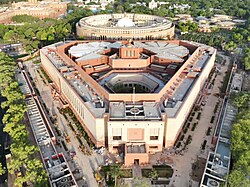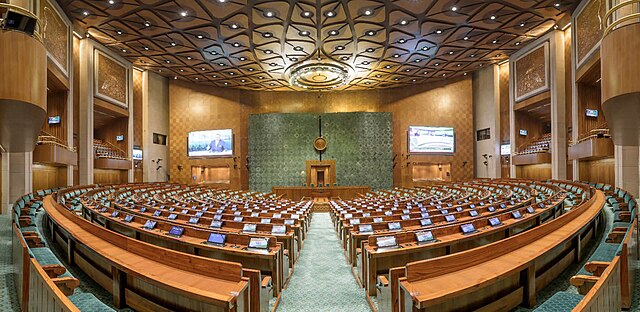Parliament House, New Delhi
Seat of the Parliament of India From Wikipedia, the free encyclopedia
Seat of the Parliament of India From Wikipedia, the free encyclopedia
Parliament House (ISO: Saṁsada Bhavana), in New Delhi is the seat of the Parliament of India. It houses the Lok Sabha and the Rajya Sabha, which are lower and upper houses respectively in India's bicameral parliament.
| Parliament House | |
|---|---|
Saṁsada Bhavana | |
 The new Parliament House, with the Old Parliament House in the background, along with the Parliament Library Building on the right. | |
 | |
| General information | |
| Address | 118, Rafi Marg, New Delhi, Delhi |
| Town or city | |
| Country | |
| Coordinates | 28°37′02″N 77°12′36″E |
| Current tenants | Parliament of India |
| Groundbreaking | 1 October 2020 |
| Completed | 28 May 2023 |
| Opened | 19 September 2023 |
| Client | Central Public Works Department |
| Owner | Government of India |
| Height | 39.6 metres |
| Technical details | |
| Floor count | 4[1] |
| Grounds | 65,000 m2 (700,000 sq ft)[2] |
| Design and construction | |
| Architect(s) | Bimal Patel |
| Architecture firm | HCP Design, Planning and Management Pvt. Ltd. |
| Main contractor | Tata Projects Ltd. |
| Other information | |
| Seating capacity | 1,272 (Lok Sabha chamber: 888 Rajya Sabha chamber: 384) |
| Public transit access | |
| Website | |
| sansad.in | |
It is located on Rafi Marg, which crosses the Central Vista and is surrounded by the Old Parliament House, Vijay Chowk, India Gate, National War Memorial, Vice President's Enclave, Hyderabad House, Secretariat Building, Prime Minister's Office and residence, ministerial buildings and other administrative units of the Indian government.
As part of India's Central Vista Redevelopment Project, a new parliament building was constructed in New Delhi. It was inaugurated on 28 May 2023 by Prime Minister Narendra Modi.[3] The New Parliament House was first used for official business on 19 September 2023 during a Parliamentary Special Session.[4] On the same day, Women's Reservations Bill, 2023 was introduced in the parliament.[5]
Proposals for a new parliament building to replace the existing complex emerged in the early 2010s due to stability concerns with the older structure.[6] A committee to suggest several alternatives to the current building was set up by the then-Speaker Meira Kumar in 2012. The original building, a 93-year-old structure, suffered from inadequate space for house members and their staff and design changes that put its structural stability at risk as it wasn't earthquake-proof. Despite this, the building is important to India's national heritage, and plans are in place to protect the structure.[7]
In 2019, the Indian government launched the Central Vista Redevelopment Project, which included constructing a new parliament building along with other projects in New Delhi, including revamping Kartavya Path, construction of a new residence for the vice president, a new office and residence for the prime minister and combining all ministerial buildings in a single central secretariat.[8]
The groundbreaking ceremony for the construction was held in October 2020, and the foundation stone was laid by Prime Minister Narendra Modi, on 10 December 2020.[9][10] The ceremony included an interfaith prayer service performed by religious leaders.[11][12]
Although the laying of the foundation stone was allowed, a bench led by Justice A. M. Khanwilkar of the Supreme Court of India put a hold on the Central Vista Redevelopment Project until the resolution of pleas received against the project in the court.[13] The project was cleared in a majority judgment of the Supreme Court in January 2021, with riders for environmental concerns, and work on the building was begun.[14]
The old parliament architecture built in 1927 was designed by the British architects Sir Edwin Lutyens and Sir Herbert Baker;[15] and it was largely influenced by Hindu Chausath Yogini Temple, Mitaoli.[16][17]
The new complex has a hexagonal shape and it is built next to the existing complex and is almost equal in size to the former one.[18][19][20] The design of this Parliament building resembles the Vijaya Temple of Vidisha.[21]
The building is designed to have a lifespan of more than 150 years.[1] It is designed to be earthquake resistant while incorporating architectural styles from different parts of India.[10] The Lok Sabha and the Rajya Sabha chambers have large seating capacities to accommodate more members in the future, resulting from India's growing population and consequent future delimitation exercises.[10]

The complex has 888 seats in the Lok Sabha chamber and 384 seats in the Rajya Sabha chamber. Unlike the old parliament building, it does not have a central hall. The Lok Sabha chamber is able to house 1,272 members in case of a joint session.[10] The rest of the building has four floors with offices for ministers and committee rooms.[1]
The building has a built area of 20,866 square metres (224,600 sq ft) (including its open-sky area of 2,000 square metres (22,000 sq ft) for a banyan tree), which makes it 10% smaller in size than the existing old circular building of 22,900 square metres (246,000 sq ft) (diameter 170.7 metres (560 ft)) including its open sky area of 6,060 square metres (65,200 sq ft), split into three sectors.[22]
The Parliament House has three entrances, named Gyan Dwar (knowledge gate), Shakti Dwar (power gate), and Karma Dwar (karma gate).[23] There are six guardian statues that man the three entrances, namely, Gaja, Ashwa, Garuda, Makara, Shaardoola, and Hamsa.[24]
A foucault pendulum is suspended from the ceiling of the central foyer. This pendulum, created by the National Council of Science Museums in Kolkata, is the largest of its kind in India, standing at a towering height of 22 meters and weighing an 36 kg. As it rotates on its axis, the pendulum almost reaches the floor, hanging from a skylight positioned at the top of the Constitution Hall. Its presence symbolizes the integration of India's concept with the vastness of the cosmos.[25]
The Lok Sabha chamber at the new building houses The Sengol.[26] The gallery Shilp Deergha (crafts gallery) was conceptualised with eight themes: Parv (festival), Swabalamban (self-reliance), Prakriti (nature), Ullas (joy), Gyan (wisdom), Samrasta (harmony), Astha (faith), and Yatra (journey). About 255 crafts were sourced from around 400 artisans from across the country.[24]

On 28 May 2023, Prime Minister Narendra Modi officially inaugurated India's new parliament building. The ceremonies began in the morning, with Modi unveiling a plaque dedicating the building to the nation and addressing a gathering of lawmakers.[27] As part of the inauguration ceremony, following a Tamil Hindu tradition,[28] Adheenam priests handed over a gold-plated scepter, Sengol to PM Modi, who installed it near the chair of the Speaker of the Lok Sabha in the new Parliament building.[29][30]
The opposition parties largely abstained from the event, expressing their preference for the president to open the building instead of the prime minister.[31]
During the inauguration, a 'Sarva Dharma Prarthana' (all-religious prayer) was performed in which religious leaders from Hinduism, Zoroastrian, Baháʼí Faith, Judaism, Islam, Jainism, Buddhism and Sikhism were present.[32][33]
Formal House proceedings in the newly inaugurated building commenced on the auspicious Ganesh Chaturthi day of 19 September 2023.
Despite the boycott and criticism led by the Congress party of India, more than 300 members of Parliament attended the inauguration.[34][35] At least 19 opposition parties boycotted the inauguration, highlighting their discontent with Modi's leadership.[36] They expressed concern that President Droupadi Murmu, the head of state and highest constitutional authority, was sidelined from the event.[37] Opposition parties accused the government of passing controversial legislation without adequate debate and criticized the "disqualification, suspension, and muting" of opposition lawmakers.[38] They argued that with the erosion of democratic values within the Parliament, the new building held little significance. Rahul Gandhi, a member of the Indian National Congress, accused Modi of treating the ceremony as a coronation, emphasizing the need for parliamentary proceedings to remain focused on representing the people rather than showcasing personal grandeur.[39]
A mural that depicts a map of Maurya Empire, an undivided India in the new parliament caused a diplomatic row with neighbouring Nepal, Pakistan and Bangladesh. On 28 May 2023, India's parliamentary affairs minister Pralhad Joshi tweeted a photo of the mural with a sentence in Kannada, a translation of which says, "Resolve is clear – Akhand Bharat".[40][41] The same day, Manoj Kotak, a BJP politician, also tweeted, "Akhand Bharat in (the) New Parliament. It represents our powerful and self reliant India".[42]
On 30 May 2023, former prime minister of Nepal KP Sharma Oli criticised the action stating that "If a country like India that sees itself as an ancient and strong country and as a model of democracy puts Nepali territories in its map and hangs the map in Parliament, it cannot be called fair".[43] Baburam Bhattarai, former prime minister of Nepal, also criticised "The controversial mural of 'Akhand Bharat'" that according to him "has the potential of further aggravating the trust deficit already vitiating the bilateral relations between most of the immediate neighbours of India".[44]
On 1 June 2023, Pakistan's Foreign Office spokesperson Mumtaz Zahra Baloch expressed concern stating that "We are appalled by the statements made by some BJP politicians, including a union minister, linking the mural with 'Akhand Bharat'".[45]
On 6 June 2023, Bangladesh's Minister of State for Foreign Affairs Shahriar Alam stated that his government is in the process of seeking clarification from India regarding the map.[46]
On 8 June 2023, replying to concerns, India's foreign minister S. Jaishankar said, "The mural of undivided India shows the spread of the Ashoka empire and the idea of responsible and people-oriented governance". To Pakistan's criticism, he said that Pakistan cannot understand it because it does not have the power to understand and added that the neighbouring countries will understand the meaning of the mural.[47] Arindam Bagchi, spokesperson of India's Ministry of External Affairs had also previously clarified that the mural depicted the spread of the Mauryan period in Indian history.[48]
On 13 December 2023, the 22nd anniversary of the 2001 Indian Parliament attack, two intruders from the visitor's gallery entered the Lok Sabha chamber and opened smoke bombs. The proceedings in both Lok Sabha and Rajya Sabha were adjourned initially but were resumed after a while. Four people have been arrested in this matter. Speaker of the Lok Sabha Om Birla has initiated a probe into the matter. Members of parliament condemned this major security lapse and questioned the security arrangements in the premises. A meeting was organised later in the day by the speaker of the Lok Sabha with the members of parliament and a decision was made to ban the issuance of visitor passes.[49][50][51]
Seamless Wikipedia browsing. On steroids.
Every time you click a link to Wikipedia, Wiktionary or Wikiquote in your browser's search results, it will show the modern Wikiwand interface.
Wikiwand extension is a five stars, simple, with minimum permission required to keep your browsing private, safe and transparent.